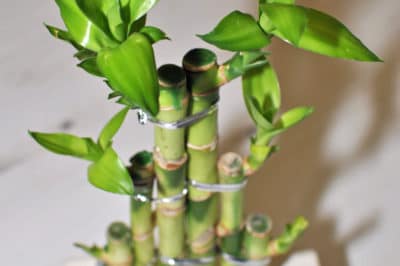About Lucky Bamboo
Although it does look like true bamboo, lucky bamboo is actually a member of the draceana family. Related to plants that have earned the nickname “dumb cane,” it can cause problems for pets that nibble at its light green leaves. It can obtain the bulk of its nourishment from plain water. An easy-care houseplant, it can also be grown outdoors in USDA Zones 10 and 11.
Light Requirements
Adequate light is probably the most important aspect of growing lucky bamboo. This is a tropical plant in its native habitat, and it needs at least 10 hours of bright indirect light every day. However, it can’t handle very much direct sun. A sunny windowsill is a good choice if you use translucent screens or shades to prevent strong sunlight from hitting the plant.
Water for Lucky Bamboo
The right kind of water is important for lucky bamboo health. Always use room temperature water. Choices from best to worst:
- Rainwater – naturally soft and free of chemicals.
- Filtered water – free of chemicals but may be more expensive.
- Distilled water – you’ll probably need occasional fertilizer.
- Tap water – worst choice, especially if softened or treated with chlorine or fluoride.
Fertilizer for Lucky Bamboo
Lucky bamboo usually has minimal fertilizer needs. Nitrogen is the primarily element it requires and it is able to obtain that from water. Pouring the water back and forth from a height oxygenates it and increases nitrogen content. You can also add a single drop of liquid fertilizer to the water once a month, especially if using distilled water.
Lucky Bamboo in Soil
While it grows well in water, lucky bamboo will also do quite well in soil. Mix commercial potting soil with sand or perlite to promote drainage. The soil should be constantly moist but not soggy. Follow the recommendations for water as noted above. Use slow-release fertilizer and be careful not to us too much fertilizer. You may need to repot occasionally.
Problems When Growing Lucky Bamboo
Lucky bamboo doesn’t usually have problems if you follow the basics for care. Too much fertilizer or sunlight can cause yellowed leaves. Contaminated water can induce root rot. Change water at least every two weeks and thoroughly clean the container. Prevent algae overgrowth with frequent water changes and opaque containers.
